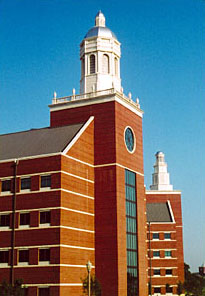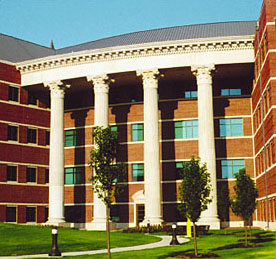Big Scaffolding Projects Don't Necessitate Big Headaches
By Masonry
Baylor University Science Building
Mason Contractor: Brazos Masonry, Inc., Waco, Texas
Architect: HarleyEllis, Southfield, Mich.
General Contractor: The Beck Group, Dallas
 The project presented a major scaffolding challenge. For the block work, traditional frame scaffold was utilized, working from floor to floor on the inside. The dampproofing crew used suspension scaffolding and a boatswain's chair, while the veneer crew worked from a heavy-duty climbing tower system. Coordination between the systems and the specific crews was an everyday priority, with 504,000 square feet of scaffolding at heights of more than 60 feet.
The project presented a major scaffolding challenge. For the block work, traditional frame scaffold was utilized, working from floor to floor on the inside. The dampproofing crew used suspension scaffolding and a boatswain's chair, while the veneer crew worked from a heavy-duty climbing tower system. Coordination between the systems and the specific crews was an everyday priority, with 504,000 square feet of scaffolding at heights of more than 60 feet.
Crews installed 180,000 grey CMU. The details around the wing section windows made use of three sizes of CMU in a complicated step-in and step-out pattern. This design was necessary to accommodate the cast stone / custom CMU / brick convergence at the exterior. The architect used 31,000 custom CMU; 5,100 square feet of cast stone; and 1,000,000 modular face brick in an accent banding pattern for the envelope.
At one point, the crew size reached 96 onsite employees. Making efficient use of staffing, equipment, material and time, Brazos Masonry was able to complete the $3.7 million contract in an approximate 15-month timeframe.
The following interview with Mackie Bounds, Owner of Brazos Masonry, Inc., describes the logic, strategies and pure willpower that the management and crews used to execute the needs of this elaborate worksite that would later become the Baylor Science Building.
Masonry: Why was it necessary for your crews to use different types of scaffolding on this project?
Bounds: There were two issues. One is a safety issue. There were areas in this building where conventional scaffolding was not safe for my personnel, so I went to a jack-up scaffolding system, which has a built-in rail system. You deck it once and you don't have to worry about moving boards.
Another very large issue was scheduling. This entire building has a CMU back-up wall. To help us meet the schedule, we put conventional scaffolding inside the building, started the CMU and, as we completed elevations, we then set up jack-up scaffolding on the exterior of the building to start the face brick.
Masonry: Didn't this project take a year?
Bounds: It took one year to lay one million brick and 450,000 block, along with over 5,000 pieces of cast stone.
Masonry: And didn't you also use swing scaffolding on this project?
Bounds: We used the swing scaffolding for the waterproofing system. So we had three scaffolding systems going all at one time, each one performing a portion of the job in that timeframe, and none of them interfering with the other's operation. The only way we were able to do that was to diversify the scaffold system on the building.
Masonry: Why did you choose the swing scaffold for the waterproofing?
Bounds: The swing stage system would allow you to get out in front. We did not have to worry about the ground being smooth. Temporary lines were being run into the building; our swing scaffolding wasn't in the way of that. We were able to hang it from the roof and get ahead. That way, we could set our jack-up scaffolding so it would work into the sequencing of the rest of the project and with the other subs on the job.
Masonry: If you had stuck with one or two different types of scaffolding, would that have extended the project timeframe?
Bounds: It would have extended the project timeframe by at least three months, which turns into dollars. And the reason for that was we would have had to wait for all the temporary lines and the dirt work to be totally completed around the exterior of the building before we could set up the jack-up scaffolding. Then we would have had to take the scaffolding all the way to the top for the damproofing and then bring it back down to start the brickwork. Actually, it could have turned into probably a four- to five-month extension when you take all the different pieces into consideration.
Masonry: I understand having the various different types of scaffolding improved safety, but having over 90 masons on the job site probably also increased safety risks. So what all was involved with that?
Bounds: On this particular project, we had a full-time safety inspector onsite.
Masonry: Is that not typical?
Bounds: Not usually. We have a full-time safety director who does site inspections, but on this particular project, with all the different scaffolding issues involved, we kept a man full-time onsite and monitored the scaffolding three times a day.
We also had scaffolding training sessions every other week for all of our personnel to keep them reminded of the different scaffolding that they were using, how we had to be tied off on certain systems, and just to keep people informed of the systems. And in that, of course, we were reducing our risk as much as possible, but we still had the concern of an employee coming off the conventional scaffold and getting onto the jack-up scaffolding. We wanted to make sure the transition takes place in his head that he has changed systems.
My biggest concern was having my crews going from a jack-up system to a conventional because there was a lot of built-in safety on the jack-up system, whereas, on the conventional system, you're dependent upon personnel making sure safety rails are in place, boards are being raised, and toeboards are being put back into place.
 Masonry: When you have so many different systems going on in so many different places, how many competent persons do you need to have available for something like that?
Masonry: When you have so many different systems going on in so many different places, how many competent persons do you need to have available for something like that?
Bounds: We had to have at least three competent scaffolding personnel on this job site. And we had one for each system. Then we went beyond that, and we required our superintendent and foreman for this job to take competent scaffold training. So, as this project was being built, there were times I had up to as many as 10 competent scaffold people on this job site.
Masonry: Other than the safety issues, what were some other issues with having so many different types of scaffolding on the same project?
Bounds: Well, our big issue with having so many different scaffold systems was that other trades wanted to borrow our scaffolding. And we're very, very particular as far as requiring them to sign releases and making sure they have the proper insurance in place. But even beyond that, we also require that these individuals have the proper scaffolding training to even get on a particular system.
We've always tried to work with other project teams and allow them to use our scaffold as long as it did not delay our activities. It was a much bigger challenge on a project like this because so many other trades wanted to get in there and use our scaffolding. That was another reason we had to have a full-time safety person ? just to keep our fellow trade companies in line with safety and proper training on our scaffold.
Masonry: Was there an issue scheduling the different scaffolding as far as 'this one needs to be here at a certain time?' Was that an issue or was it fairly plain and simple for your foreman and supervisors?
Bounds: It was a commonsense decision. It was not a real challenge for us to meet the schedule.
We knew the CMU had to get started at a very early stage ? we went to the conventional scaffolding system. We were scaffolding off of a concrete surface from the interior. We also knew that, for our brickwork to flow as it needed to, we had to get the swing stage out and ahead of the jack-up system.
But at the same time, we had take into consideration, 'OK, there are other trades that are having to get preparation done, too.' We couldn't interfere with them, but we didn't want them interfering with us. It was commonsense that we put the swing stage up out in front of the jack-up system and get the damproofing system and flashing in place, before the jack-up system was ever set up.
Masonry: Did you not also use a boatswain's chair?
Bounds: On the punch list ? once again, due to schedule ? they had to get their grass, landscape and sidewalks in. We did use a boatswain's chair to do the touch-up cleaning. There was some stone patching that we had to do also, but again it was strictly a scheduling issue. We did not want to be accused of holding up some other trade as this job was wrapping up.
Masonry: Did anything unusual happen on this project?
Bounds: One thing that happened on this project that wasn't advertised: I woke up one morning at about 4:30 and flipped the radio on, and the first thing I heard was that the new Baylor Science Building was on fire. I rushed down to the job site ? you could see flames shooting up out of the roof. ... And the job still completed three months ahead of schedule.
Masonry: Wow! What caused the fire?
Bounds: The fire was caused by an electrical hookup on an AC unit. The only thing that saved the building was a CMU firewall that we had built. If it hadn't been for that, the building probably would have went to the ground. It was unbelievable, the intensity of the heat and what it was doing to the structure. A simple CMU firewall that was added after the fact saved the structure.
Masonry: That's excellent! OK, one final question: Did your crews incur any injuries during this project?
Bounds: We had some very minor injuries ? your typical construction site injuries; however, we didn't have any OSHA citations or major accidents throughout the project.
From a safety standpoint, it was outstanding. I give a lot of credit to my Safety Manager, Zach Everett, and to my entire staff for the emphasis they put on safety at every job site we're on.
Masonry: Is there anything else you'd like to add?
Bounds: I think scaffolding is an area of the masonry industry that we do not advertise enough. We're a changing industry, and scaffolding is a very big part of our business. Our scaffold suppliers have come forth with some very versatile scaffolding systems that help the consumer and I think, as mason contractors, we need to promote the fact that we're not just the frame scaffolding contractor anymore. We use our jack-up systems; we use the electrical scaffolding systems, like the Hydro Mobile and Fraco units. I mean we can do so much more now than we used to, and do it in a safe way, while also cutting time off the schedule.
Masonry: Thank you so much for your time, Mackie.
About the Author
Masonry, the official publication of the Mason Contractors Association of America, covers every aspect of the mason contractor profession - equipment and techniques, building codes and standards, business planning, promoting your business, legal issues and more. Read or subscribe to Masonry magazine at www.masonrymagazine.com.


















